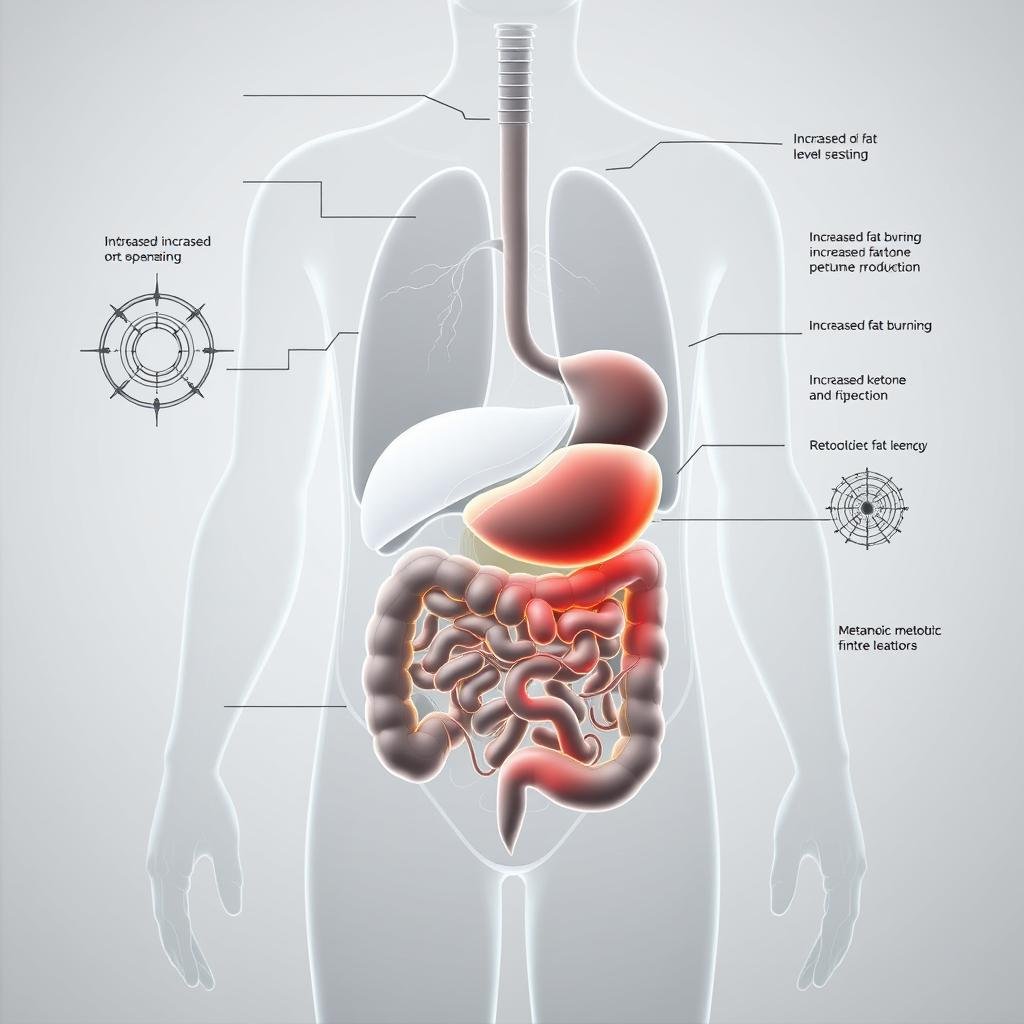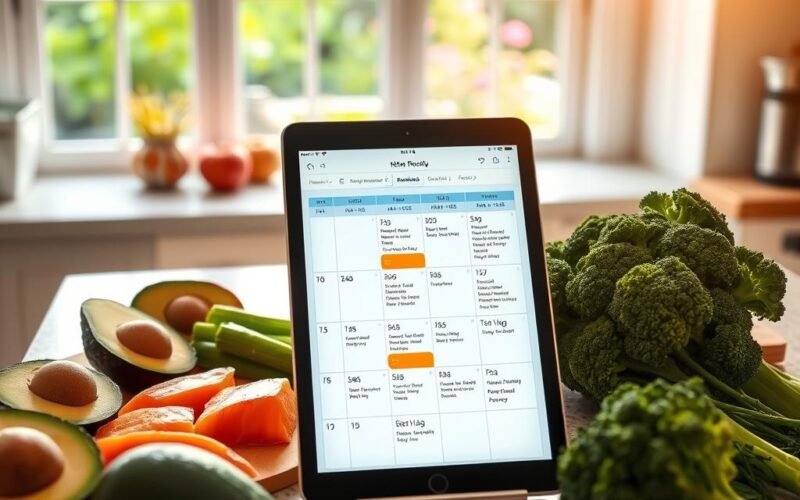Did you know your metabolism slows by up to 10% every decade after 50? This makes weight management harder as you get older. Keto and intermittent fasting over 50 can help, with studies showing up to 30% more weight loss than traditional diets.
These methods are popular because they support healthy aging and tackle metabolic challenges of aging. The keto diet helps control blood sugar. Time-restricted eating lets your body use fat stores more efficiently.
For seniors looking for lasting weight loss, these methods offer more than just weight loss. They also improve mental clarity, sleep, and energy. These benefits are very valuable in this life stage.
This guide will show you how to safely start these diets. We’ll help you tailor them to your needs and overcome challenges. You’ll learn how to adapt these strategies to your changing body while aiming for long-term health.
Key Takeaways
- Metabolism naturally slows by approximately 10% each decade after 50, making weight management more challenging
- The combination of ketogenic eating and fasting windows addresses age-specific metabolic changes
- These approaches can improve more than weight – including mental clarity, energy levels, and sleep quality
- Proper implementation requires understanding your unique nutritional needs as you age
- Both strategies can be customized and modified to accommodate health conditions common after 50
- Consultation with healthcare providers is essential before beginning these dietary approaches
The Benefits of Combining Keto and Intermittent Fasting
For adults over 50, combining keto and intermittent fasting offers big health benefits. This mix is not just for losing weight. It also helps with many health issues that come with age. Together, they create a great environment for your body to stay healthy and full of energy.
Why This Approach Is Gaining Popularity Among Seniors
More and more adults over 50 are trying keto and intermittent fasting together. This is because it helps you get into a fat-burning state faster. It’s a powerful way to improve your health.
When you combine keto and intermittent fasting, your body starts using fat for energy sooner. This happens because your insulin levels drop during fasting. This is exactly what the ketogenic diet aims for.
This mix is great for those who have trouble losing weight in midlife. It uses your body’s changing metabolism to your advantage. Many people find they can lose weight again after hitting a plateau.
The biggest benefit for seniors is better insulin resistance management. As we get older, our bodies don’t respond as well to insulin. This can lead to high blood sugar and fat storage. Both keto and fasting improve insulin sensitivity, but together they are even more effective.
Intermittent fasting may help your body reach ketosis quicker than the keto diet alone. That’s because your body, when fasting, maintains its energy balance by shifting its fuel source from carbs to fats — the exact premise of the keto diet.
Seniors also notice better brain function. The ketones from this diet give your brain a boost. This can help with focus and mental clarity, which often decline with age.
This approach also reduces inflammation, which gets worse with age. Chronic inflammation can lead to many health problems. Both keto and fasting have anti-inflammatory effects, making them a powerful combination.
What You Can Expect from This Guide
This guide will teach you how to safely and effectively use keto and fasting after 50. We’ll explain the science behind these methods and why they’re good for your age group.
You’ll learn how to decide if this approach is right for you. We’ll cover important safety tips and how to avoid medication problems. We know health needs change with age, so we’ll help you adjust if needed.
The guide will show you how to start slowly. You’ll learn how to gradually add keto and fasting to your life. This way, you’ll avoid discomfort and increase your chances of success.
We’ll tell you which foods to eat and avoid. We’ll focus on the nutritional needs of older adults. You’ll also get tips on what to eat during fasting periods to stay comfortable.
We’ll talk about common mistakes seniors make and how to avoid them. You’ll learn how to track your progress and stay motivated. This will help you enjoy your journey.
Lastly, we’ll give you a 7-day meal plan with recipes and fasting schedules for adults over 50. By the end of this guide, you’ll have everything you need to improve your health, energy, and quality of life in your golden years.
Understanding Keto and Intermittent Fasting Over 50
For adults over 50 looking to change their lifestyle, learning about ketogenic eating and intermittent fasting is key. These methods help seniors improve their health, manage weight, and boost energy. It’s important to know how they work, as our bodies change with age.
What Is the Ketogenic Diet?
The ketogenic diet, known as keto for seniors, focuses on high fat, moderate protein, and very low carbs. It’s a big change from the usual American diet, which has lots of carbs. This diet cuts carb intake to 20-50 grams daily.
By cutting carbs, your body changes how it makes energy. It starts making ketones from fat instead of carbs. This is called fat adaptation.

The diet’s macronutrient breakdown is: 70-80% fat, 15-25% protein, and 5-10% carbs. This ratio puts your body in ketosis, where it burns fat for energy.
For seniors, this can be very helpful. As we age, it’s harder to lose weight. Using fat as energy can help maintain a healthy weight and enjoy nutritious foods.
The ketogenic diet is different from other low-carb diets. It focuses on specific macronutrient targets to keep you in ketosis. This requires careful carb restriction and enough fat.
What Is Intermittent Fasting?
Intermittent fasting (IF) is not a diet but a pattern of eating. It involves fasting and eating in specific time windows. It focuses on when you eat, not what.
It doesn’t change the foods you eat but organizes your meals. During fasting, you eat very little or nothing. During eating times, you can eat normally or follow a diet like keto.
There are many intermittent fasting methods:
- 16/8 Method: Fast for 16 hours, eat in an 8-hour window (e.g., 12 pm to 8 pm)
- 5:2 Protocol: Eat normally five days, restrict calories (500-600) on two non-consecutive days
- Eat-Stop-Eat: Fast for 24 hours one or two times a week
- Alternate-Day Fasting: Fast every other day, either completely or with minimal calories
Intermittent fasting affects how your body processes food and insulin levels. When you eat, insulin helps cells use glucose. During fasting, insulin levels drop, improving insulin sensitivity over time.
For seniors, intermittent fasting offers unique benefits. As we age, our cells become less responsive to insulin. Regular fasting can help restore this sensitivity, reducing the risk of type 2 diabetes and other metabolic issues.
Fasting also triggers cellular repair and autophagy. Autophagy is your body’s way of cleaning out damaged cells to replace them with new, healthy ones. This is important as we age and cellular damage builds up.
Combining keto with intermittent fasting can enhance fat burning. Fasting periods help deplete glycogen stores, speeding up the transition to fat-burning. This can also reduce the initial discomfort of adapting to a ketogenic lifestyle.
Why This Combination Works Better After Age 50
After 50, your body changes how it handles food and metabolism. This makes the keto-fasting combo a great choice. It’s easier to manage weight, but the changes also make the combo more effective than each alone.
Studies show that intermittent fasting can help your body get into ketosis faster than just the keto diet. When you fast, your body starts using fats for energy, just like the keto diet aims. This is very helpful for people over 50.
Metabolic Changes in Your Golden Years
After 50, your metabolism changes a lot. These changes affect how you process nutrients and store energy. It’s important to understand these changes to address them well.
One big change is losing muscle mass, or sarcopenia. You start losing 3-5% of muscle per decade from age 30. But after 50, it speeds up. Muscle burns more calories than fat, so losing it slows down your metabolism.
Hormonal changes also play a big role. Women see a big drop in estrogen during menopause. Men’s testosterone levels slowly go down. These changes affect how fat is stored, often leading to more belly fat and insulin resistance.
Your cells become less responsive to insulin as you age. This means your blood sugar levels can go up and you store more fat, mainly around your belly. This makes it harder for your body to switch between carbs and fats for energy.
| Metabolic Change After 50 | Impact on Your Body | How Keto Helps | How Fasting Helps |
|---|---|---|---|
| Decreased Muscle Mass | Lower resting metabolic rate | Protein-rich approach preserves muscle | Triggers growth hormone release |
| Hormonal Changes | Increased abdominal fat storage | Reduces insulin levels | Improves hormone sensitivity |
| Reduced Insulin Sensitivity | Higher blood sugar, more fat storage | Minimizes carb intake | Resets insulin response |
| Decreased Mitochondrial Function | Less efficient energy production | Provides clean fuel source | Promotes mitochondrial renewal |
How Keto and IF Address Age-Related Challenges
The combo of keto and IF is a strong metabolic renewal strategy for those over 50. It tackles the challenges of weight management in this age group.
Ketogenic eating bypasses glucose metabolism issues by using ketones as fuel. This is great as you age and your cells get less efficient at using glucose. By eating fewer carbs, keto after 50 keeps insulin levels low, improving insulin sensitivity over time.
Intermittent fasting adds to these benefits by giving your digestive system breaks. These fasting periods lower insulin levels, helping restore insulin sensitivity. Fasting after 50 also starts autophagy, your body’s way of cleaning out damaged cells and slowing aging.
Together, these methods create a metabolic environment that fights age-related changes. Studies show this combo can help you get into ketosis faster and lose more body fat than keto alone. This is a big plus for adults over 50 who struggle with stubborn weight gain.
This combo also helps with hormone optimization. Intermittent fasting boosts human growth hormone production, which decreases with age. This hormone is key for keeping muscle and bone density, important for aging adults.
Both methods are natural metabolism boosters by:
- Improving mitochondrial function and energy production
- Reducing chronic inflammation that can slow metabolism
- Enhancing fat-burning capabilities through metabolic flexibility
- Supporting better sleep quality, which affects metabolic rate
For adults over 50, the keto-fasting combo is a smart way to manage weight. It works with your body’s changes, not against them. This approach can help restore metabolic function that naturally declines with age.
Safety First: Is This Approach Right for You?
Keto and intermittent fasting can be great for seniors, but it’s not for everyone. These methods help with health and living longer, but they’re not right for all over 50. It’s important to know the risks and make changes carefully before starting.
Many ask, “is keto and fasting safe after 50?” It depends on your health, medicines, and goals. Let’s look at the safety things you should think about before starting.
Health Conditions That Require Special Consideration
Older adults with certain health issues might need to change keto and fasting plans. Some conditions might make these plans not safe without a doctor’s watch.

Diabetes is a big concern with keto and fasting. These methods can help with insulin resistance, but they also change blood sugar levels. If you take diabetes medicines, you’ll need to watch your blood sugar closely.
Heart health is also important. Starting keto might raise cholesterol levels in some people. If you have heart disease or high cholesterol, your doctor should check your levels closely.
Kidney health is another key area. The keto diet has more protein, which might not be good for kidneys. You might need to get your kidneys checked often if you start.
| Health Condition | Keto Considerations | Fasting Considerations | Recommended Modifications |
|---|---|---|---|
| Type 2 Diabetes | May improve insulin sensitivity but requires medication adjustments | Can affect blood sugar levels; requires close monitoring | Start with shorter fasting windows; adjust medications with doctor supervision |
| Heart Disease | Monitor cholesterol; emphasize healthy fats | Generally safe but start gradually | Focus on Mediterranean-style keto with omega-3 rich foods |
| Kidney Disease | High protein intake may be problematic | Dehydration risk; electrolyte imbalances | Moderate protein intake; increase water consumption |
| Osteoporosis | Ensure adequate calcium and vitamin D | Potential nutrient deficiencies if not planned well | Include calcium-rich keto foods; consider supplements |
Thyroid issues might be affected by big diet changes. Some studies say very low-carb diets could hurt thyroid function. It’s smart to keep an eye on your thyroid hormones if you have thyroid problems.
If you’ve had eating disorders, keto and fasting might not be safe. Less strict ways to eat healthy might be better for you.
Medication Interactions to Be Aware Of
Many seniors take lots of medicines, some of which can react with keto or fasting. Knowing these interactions is key for safety and success.
Medicines for blood pressure often need to be changed when you start keto and fasting. These diets can lower blood pressure, which might make your medicine too strong. This could cause low blood pressure.
Diabetes medicines, like insulin, can be risky. As you get more insulin sensitive, you might need less medicine. Without adjusting, this could lead to low blood sugar.
Diuretics and keto can increase dehydration and electrolyte imbalances. This is a big risk, mainly when you’re first starting.
Cholesterol medicines might need to be changed as your cholesterol levels change. Some people see better cholesterol levels on keto, while others might see temporary increases.
Medicines that need food to work right or to avoid stomach problems might need to be taken at different times. You might need to take your medicine during your eating window.
When to Consult Your Healthcare Provider
It’s very important to talk to your doctor before starting keto and fasting after 50. This is not just a good idea—it’s often necessary.
You should always consult your doctor before starting if you have health problems like diabetes, heart disease, kidney disease, or liver issues. These conditions need careful watching during diet changes.
Getting a full health check before starting is a good idea. This might include blood tests to check your cholesterol, blood sugar, and kidney and liver function. These tests are important to keep an eye on while you’re changing your diet.
If you take medicines, talk to your doctor and pharmacist about possible problems. You might need to change your medicine dosage or when you take it to fit your new diet.
Finding a doctor who knows about aging and these diets can be hard but worth it. If your doctor isn’t familiar with keto or fasting, you might want to get a second opinion from a functional medicine doctor or a dietitian who knows about these topics.
When talking to your doctor about these diets, bring research and questions. Ask about how often you should check in, what signs to watch for, and how to monitor your health during the change.
Remember, trying to live longer with diet changes should never risk your health now. With the right medical advice, many seniors over 50 can safely use keto and fasting to help their health goals.
Step-by-Step Guide to Starting Keto and IF After 50
Starting keto and intermittent fasting after 50 is about taking small steps. It’s not about jumping in too fast. Many adults rush into these diets and then give up. This guide helps you take it slow, making it easier for your body to adjust.
Phase 1: Preparing Your Body and Kitchen
Before you start changing your diet, get your kitchen ready. This first phase takes 1-2 weeks. It’s all about setting up your space for success.
Start by cleaning out your kitchen. Get rid of foods high in carbs like pasta and sugary snacks. Replace them with keto-friendly foods like nuts, seeds, and healthy oils.
Get the right items for your low-carb diet:
- Quality proteins (eggs, fatty fish, grass-fed meats)
- Healthy fats (avocados, olive oil, coconut oil)
- Low-carb vegetables (leafy greens, broccoli, cauliflower)
- Nuts and seeds (almonds, walnuts, chia seeds)
- Electrolyte supplements (important for older adults)
Drinking enough water is key as you get older. Get a good water bottle and drink more. Older adults might also need certain supplements when starting keto, like:
- Magnesium (helps with muscle cramps and sleep)
- Vitamin D (supports bone health and immunity)
- Potassium (keeps the heart working right)
- B vitamins (helps with energy)
Getting mentally ready is just as important. Be realistic and know your journey might be different. Track more than just weight—energy, sleep, and mood are important too.
Phase 2: Easing Into Ketogenic Eating
Don’t cut carbs too fast, it’s better to do it slowly. This phase lasts 2-3 weeks. It’s all about slowly cutting down on carbs.
Start by getting rid of obvious carbs and sugars. Drink water instead of sugary drinks. Use low-carb alternatives for bread and snacks. These small changes help avoid headaches and irritability.
Slowly lower your carb intake over time:
- Week 1: 100-125g carbs daily (cut out sugars and refined carbs)
- Week 2: 75-100g carbs daily (reduce starchy veggies and grains)
- Week 3: 50-75g carbs daily (focus on good carb sources)
- Week 4: 20-50g carbs daily (standard keto range)
For adults over 50, your macronutrient needs might be different. A good starting point is:
- Carbohydrates: 5-10% of daily calories
- Protein: 20-25% of daily calories (a bit more to keep muscle)
- Fat: 65-75% of daily calories
Watch for signs you’re adapting well, like more energy and less hunger. If you feel really tired or have other bad symptoms, slow down.
Phase 3: Introducing Fasting Windows
Once you’re used to keto, start adding fasting periods. Start with small fasting times and gradually increase them.
Begin with a 12:12 schedule—eat for 12 hours, then fast for 12. This means stopping eating at 7 PM and not eating again until 7 AM. Many people already do this naturally.
After a week or two of 12:12, increase your fasting time by an hour every few days. You can try different schedules like:
- 14:10 (14 hours fasting, 10-hour eating window)
- 16:8 (16 hours fasting, 8-hour eating window)
- 18:6 (18 hours fasting, 6-hour eating window)
If you take medication, talk to your doctor about timing it with your fasting. Some meds need food, so you might need to adjust.
Manage hunger during fasting by:
- Drinking plenty of water, black coffee, or tea
- Adding a pinch of salt to water for electrolytes
- Keeping busy with light activities to distract from hunger
- Practicing mindfulness or meditation when cravings hit
Phase 4: Combining Both Approaches Effectively
The last phase is about mixing keto and fasting for the best results. This takes 1-2 weeks to get right.
Timing your meals is key when combining these diets. Here are some tips:
- Start with a moderate-sized, fat-rich meal to ease digestion
- Eat your biggest meal in the middle of your eating window
- Have a light, protein-rich meal before fasting
- Avoid eating close to bedtime, no matter your fasting schedule
Many adults over 50 find success with these specific combinations:
| Approach | Fasting Schedule | Keto Adaptation | Best For | Considerations |
|---|---|---|---|---|
| Gentle Start | 12:12 or 14:10 | Moderate (50g carbs) | Beginners, medication-dependent | Easiest adaptation, minimal side effects |
| Balanced Approach | 16:8 | Standard (30g carbs) | Most adults over 50 | Good balance of results and sustainability |
| Accelerated Results | 18:6 | Strict (20g carbs) | Experienced, healthy individuals | Requires careful monitoring, not for beginners |
| Therapeutic Focus | 16:8 with 24hr fast weekly | Very strict (15g carbs) | Specific health goals | Requires medical supervision |
| Maintenance Mode | Flexible (5:2 approach) | Cyclical keto (varying carbs) | Long-term sustainability | Good for social flexibility and maintenance |
Listen to your body and adjust as needed. Some days might need more flexibility, like during social events or travel. The goal is to be consistent, not perfect.
Remember, keto and fasting together can be powerful. If you feel really tired, dizzy, or have other bad symptoms, slow down. It’s better to ease back than to push too hard.
Always focus on getting enough protein to keep your muscles strong, which is more important after 50. Aim for 1.0-1.2 grams of protein per kilogram of your ideal weight, spread out in your eating window.
The Ideal Foods for Keto While Practicing Intermittent Fasting
For adults over 50, choosing the right foods is key when mixing keto and intermittent fasting. This mix requires careful thought. The right foods can boost your results and meet your health needs after 50.
Good nutrition is essential for balancing ketogenic meal plans with fasting. Your body’s needs change with age, so pick your foods wisely during eating times.
Foods to Embrace on Your Plan
The heart of healthy eating for seniors is nutrient-dense foods. As you age, your body needs more nutritional value from fewer calories. So, food quality is very important.
High-quality proteins should be your first choice. Fatty fish like salmon and mackerel are great for brain and heart health. Pasture-raised eggs and grass-fed meats also offer important nutrients.
Healthy fats are also key. Extra virgin olive oil fights inflammation. Avocados are rich in potassium. Nuts and seeds provide magnesium, which is good for muscles and sleep.
Low-carb veggies should fill your plate. Leafy greens like spinach and kale are good for bones. Broccoli and cauliflower support detox. Colorful peppers boost immune function and collagen.
Some foods are extra beneficial for aging bodies. Berries provide antioxidants for the brain. Fermented foods like sauerkraut and kimchi are good for the gut. Bone broth helps with joints and sleep.
Foods to Limit or Avoid Completely
Knowing what to avoid is as important as knowing what to eat. Some foods can hinder your progress, even if they’re low in carbs.
Remove inflammatory oils first. Oils like corn, soybean, and canola can cause inflammation. Use coconut oil, avocado oil, and butter from grass-fed sources instead.
Artificial sweeteners can cause digestive problems. They may also affect gut bacteria and insulin sensitivity. Use small amounts of stevia, monk fruit, or allulose for sweetness.
Be cautious of processed “keto” products. They often have fillers, preservatives, and hidden carbs. These products lack nutrients and may cause inflammation.
Many foods seem healthy but have hidden carbs. Sauces, dressings, and marinades often have added sugars. Some spice blends and medications also contain carbs.
Alcohol’s effects change with age. It can affect medication and slow fat burning. Even low-carb drinks can disrupt sleep and fat burning.
What You Can Consume During Fasting Windows
Knowing what to drink without breaking your fast is key for weight management. Different fasting types allow different levels of consumption.
For clean fasting, stick to water, plain tea, and black coffee. These drinks won’t raise insulin levels. Adding electrolytes can prevent headaches and muscle cramps, common after 50.
Modified fasting lets you have a bit more. Adding healthy fats to coffee or tea is okay. Bone broth provides nutrients and electrolytes without raising insulin too much.
Medications need special care during fasting. Always take them as directed. Talk to your doctor about the best time for medications that might upset your stomach.
Supplements should be taken during meals, except for magnesium, potassium, and sodium. These can be helpful during fasting to keep electrolyte levels balanced.
Drinking enough water is vital after 50, even more so during fasting. Your thirst sense may decrease with age. Aim for 64 ounces of water daily, with extra electrolytes if needed.
By choosing the right foods and understanding fasting rules, you can create a sustainable plan. This plan addresses your unique needs after 50. It’s the key to long-term success with keto and intermittent fasting.
Common Mistakes to Avoid After Age 50
Combining keto and intermittent fasting can be great for adults over 50. But, there are mistakes that can hurt your results. Knowing these mistakes is key to a safe keto and fasting guide for your mature body. Let’s look at the most common errors and how to avoid them for a successful journey.
Nutritional Pitfalls Specific to Seniors
Our nutritional needs change with age. What worked in your 30s or 40s might not be right after 50. Many seniors make big mistakes when starting keto for their changing bodies.
Not eating enough protein is a big mistake. After 50, your body doesn’t process protein as well. This makes it key for maintaining lean muscle mass. Many keto followers focus too much on fats and not enough on protein, leading to muscle loss.
Bone health gets more important with age. Many seniors on keto diets don’t get enough calcium and vitamin D, which can lead to osteoporosis and fractures.

Fiber is often forgotten on keto diets. For adults over 50, this can make digestive issues worse. Include fiber-rich keto foods like avocados, chia seeds, and non-starchy vegetables to help your gut health.
Not eating enough calories is another mistake. While cutting calories can help lose weight, too much can slow your metabolism. This makes managing insulin resistance harder and can make your body hold onto fat instead of burning it.
Electrolyte imbalances are more serious for seniors. Many over-50 keto practitioners don’t adjust their sodium, potassium, and magnesium intake. This can cause blood pressure issues, muscle cramps, and heart stress.
Fasting Errors That Can Derail Progress
Fasting comes with its own set of mistakes. Knowing these can help you create the best diet for seniors to lose weight without health risks.
Starting with too long fasts is a common error. Your body needs time to get used to burning fat, which is harder after 50. Start with 12-hour fasts and slowly increase the time as your body adjusts.
Being too strict with fasting can backfire. Seniors often take medications that need food or have social plans around meals. Make your fasting schedule flexible to fit these needs without stress or medication issues.
Dehydration is common during fasting in older adults. Age can make you less thirsty, so it’s easy to get dehydrated without noticing. Drink water throughout your fasting periods and add electrolytes if needed.
Ending fasts the wrong way can upset your stomach. Many seniors end fasts with big, high-fat keto meals that are hard to digest. Instead, start with a small, easy-to-digest meal before eating more.
| Common Mistake | Why It’s Problematic After 50 | Better Approach | Expected Benefit |
|---|---|---|---|
| Inadequate protein intake | Accelerates age-related muscle loss | Consume 1.0-1.2g protein per kg of body weight | Preserved muscle mass and strength |
| Neglecting calcium and vitamin D | Increases osteoporosis risk | Include keto-friendly calcium sources and consider supplements | Better bone density maintenance |
| Fasting too long too soon | Creates excessive stress on aging systems | Start with 12-hour fasts, increase gradually | Sustainable adaptation without burnout |
| Ignoring medication schedules | Can interfere with critical health management | Design fasting windows around medication needs | Maintained health while enjoying fasting benefits |
Not adjusting your fasting plan during illness or when you’re more active can be bad. Your older body needs more recovery time than when you were younger. Be ready to shorten fasting times or pause them if your body needs more food.
Overeating on non-fasting days can undo all your fasting benefits. Some seniors eat too many calories when they’re not fasting, which can stop fat loss and insulin resistance management. Instead, focus on eating nutrient-dense, satisfying meals that support your health goals.
By avoiding these common mistakes, you can make a more effective and sustainable keto and intermittent fasting plan after 50. The goal is not to be perfect but to be aware and adapt to your body’s changing needs.
Optimizing Your Results: Senior-Specific Strategies
Getting the most out of keto and intermittent fasting after 50 means using strategies that fit your aging body. These methods are great for metabolic health and longevity. But, your body needs different things now than it did years ago. With some smart tweaks, you can get the best results while supporting your body’s changes.
Managing Energy Levels Throughout the Day
Managing energy is key when you’re over 50 and doing keto and intermittent fasting. Your body’s energy-making systems change with age. You need smart ways to keep your energy steady.
Timing your meals right can really help your energy. Eat your biggest meal in the middle of your eating window. This helps you absorb nutrients better and avoids energy crashes later.
- Try MCT oil in your morning coffee or tea for energy during fasting
- Do important stuff when your energy is highest (usually 2-4 hours after fasting)
- Use electrolytes to fight fatigue and help cells make energy
- Alternate days of more activity with rest days for energy cycling
Many people over 50 find that autophagy—cell cleaning from fasting—helps with clear thinking and energy. Start with shorter fasts and gradually increase them to get the most benefits.
Adapting for Joint Health and Mobility
Joint pain often comes with age, but your diet can help or hurt. The good news is that keto and intermittent fasting can fight inflammation. This helps your joints.
Choose anti-inflammatory foods for keto. Eat fatty fish, olive oil, avocados, and nuts for fat. These foods fight inflammation that hurts your joints.
“Plus, intermittent fasting may preserve muscle mass during weight loss and improve energy levels, which may be helpful for keto dieters looking to improve athletic performance and drop body fat.”
Don’t forget about collagen for those over 50. Your body makes less collagen with age, but it’s key for joints and skin. Add collagen peptides to your diet, best before breaking your fast.
Drinking enough water is also important for joints. Aim for 2-3 liters a day, with extra electrolytes for balance. Many seniors find less joint stiffness with good hydration on keto and intermittent fasting.
Maintaining Muscle Mass While Losing Fat
One big worry for adults over 50 is losing muscle with fat when dieting. This is even more true with intermittent fasting. Eating enough protein and doing resistance training helps keep muscle.
Protein needs go up with age. Aim for 1.0-1.2g of protein per pound of lean body mass over 50. Spread this protein out during your eating window.
- Eat 25-30g of high-quality protein with each meal in your eating window
- Include leucine-rich foods like eggs, meat, and whey protein to build muscle
- Have a protein-rich meal within 2 hours after working out
- Consider essential amino acid supplements, mainly on workout days
Resistance training is a must for fat burning for boomers. Even just two 30-minute sessions a week can help keep muscle and boost metabolic health. Focus on big exercises that work many muscles at once, adjusting as needed.
Recovery nutrition is key after 50. Break your fast with protein and carbs after exercise to keep muscle and support keto. This helps your body burn fat while keeping muscle.
By using these strategies, you can get the best results while your body changes. Remember, it’s about making small, lasting changes. These will help you more in the long run than big, short-lived changes.
Tracking Progress and Staying Motivated
For adults over 50, tracking progress and staying motivated is key. Combining keto with intermittent fasting offers a metabolic boost. It can also help manage hunger and promote fullness, aiding in weight loss.
But, it’s important to look beyond the scale. Celebrate your achievements in ways that matter to you.
Effective Metrics Beyond the Scale
The scale might not tell the whole story, but body measurements do. Waist circumference is a good indicator of metabolic health. A smaller waist can mean better insulin sensitivity and less dangerous fat.
Blood markers show your progress clearly. Track fasting blood glucose, insulin levels, and more. These numbers give you a true picture of how you’re doing.
Functional improvements are satisfying. Many seniors feel more energetic, sleep better, and have less pain. These changes are more motivating than numbers.
![]()
The “clothing test” is a practical way to see progress. If your pants fit better or you need a tighter belt, you’re doing well.
Managing Side Effects and Challenges
Starting keto and intermittent fasting can be tough, but there are ways to handle it. Knowing the challenges and how to overcome them keeps you going when you feel like giving up.
Keto flu symptoms are common at first. They include headaches, fatigue, and irritability. These usually go away in a few days. Start by slowly cutting down carbs to ease the transition.
Electrolyte imbalances can cause cramps and headaches. Your body loses more sodium, potassium, and magnesium. Taking supplements or eating foods rich in these minerals helps.
| Challenge | Common Symptoms | Senior-Specific Solution | Expected Timeline |
|---|---|---|---|
| Keto Flu | Headache, fatigue, irritability | Gradual carb reduction, increased hydration | 3-7 days |
| Electrolyte Imbalance | Muscle cramps, palpitations | Bone broth, sea salt, magnesium supplements | Ongoing management |
| Digestive Changes | Constipation, diarrhea | Fiber supplements, probiotic foods | 2-4 weeks |
| Sleep Disturbances | Insomnia, vivid dreams | Consistent eating window, magnesium before bed | 2-3 weeks |
| Exercise Fatigue | Reduced stamina, weakness | Reduced intensity temporarily, targeted protein intake | 3-6 weeks |
Sleep changes are common when starting keto and intermittent fasting. Increased cortisol can disrupt sleep. Eating within a consistent window helps regulate your body’s rhythm.
Digestive changes happen as your gut adapts. Constipation or diarrhea can occur. Eating more fiber and staying hydrated helps your digestive system adjust.
Building a Support System
Health journeys are better with friends. A strong support system boosts your chances of success with keto and intermittent fasting.
Online communities offer age-specific advice. They provide emotional support and practical tips. Facebook groups and Reddit communities are great places to connect with others.
Talking to your doctor is important. Prepare questions and track your progress. If your doctor is unsure, look for someone who knows about keto and intermittent fasting for seniors.
Family support is key. Explain your goals and why you’re making these changes. Involve them in meal planning or join them for keto meals.
Use tracking apps designed for seniors. They should be easy to use and track important metrics. Many apps also have community features.
Accountability helps when motivation is low. Set up regular check-ins or weigh-ins with a friend. Commitments with consequences can also help.
Your journey with keto and intermittent fasting is unique. By tracking progress and staying motivated, you can achieve metabolic renewal and healthy aging in a way that suits your body after 50.
Pair fasting with our Keto over 60 guide and support nutrition with senior grocery essentials.
7-Day Keto and Intermittent Fasting Plan for Adults Over 50
This 7-day plan makes keto and intermittent fasting easy for adults over 50. It combines ketogenic meal plans with fasting times for the best results. Each day builds on the last, helping your body get used to this new way of eating.
Recommended Fasting Windows by Day
Starting with short fasting times is key for those over 50. Your body needs time to adjust to new meal timing for longevity. The plan starts with 12 hours of eating and 12 hours of fasting, then gradually increases.
- Day 1-2: Start with a 12:12 schedule (12 hours eating, 12 hours fasting). Eat from 7 AM to 7 PM.
- Day 3-4: Move to a 14:10 schedule. Eat from 9 AM to 7 PM.
- Day 5-7: If you’re ready, try a 16:8 schedule. Eat from 11 AM to 7 PM.
Adjust your fasting times around your medication schedule. If you need to eat before taking morning meds, adjust your eating window. For those who are more active, the 14:10 schedule might be better.
The intermittent fasting benefits grow as your body adapts. But listen to your body. If you feel too tired or dizzy, go back to a shorter fasting time and talk to your doctor.
Simple Breakfast Options
Starting your day right is important on a low-carb diet for 50+. These breakfasts are packed with nutrients and keep you in ketosis.
- Avocado and Egg Bowl: Half an avocado, two poached eggs, and a sprinkle of everything bagel seasoning. It’s full of healthy fats and choline for your brain.
- Greek Yogurt Parfait: Full-fat Greek yogurt, 1/4 cup of mixed berries, 1 tablespoon of chia seeds, and crushed walnuts. It’s great for calcium and probiotics.
- Make-Ahead Egg Muffins: Whisk 6 eggs with spinach, bell peppers, and cheese. Bake in a muffin tin for easy breakfasts all week. It’s a great source of protein and B vitamins.
- Keto Smoothie: Blend unsweetened almond milk, half an avocado, a tablespoon of MCT oil, a scoop of collagen peptides, and spinach. It’s good for your joints and gives you energy.
Adjust these options based on how hungry you are. On days with shorter eating windows, you might skip breakfast and have lunch instead.
Satisfying Lunch Ideas
Midday meals should give you energy and keep you in ketosis. These lunch ideas are tasty and easy to make.
- Mediterranean Tuna Salad: Mix canned tuna with olive oil, olives, cucumber, cherry tomatoes, and feta cheese over mixed greens. It’s full of omega-3s for your heart and brain.
- Avocado Chicken Lettuce Wraps: Shredded rotisserie chicken, mashed avocado, lime juice, and cilantro in butter lettuce leaves. It’s a complete protein with little prep.
- Keto Soup: Bone broth soup with cauliflower, spinach, grass-fed ground beef, and heavy cream. Make it in big batches and freeze for later.
- Dining Out Option: A bunless burger with a side salad (olive oil and vinegar dressing) or grilled salmon with non-starchy veggies. Ask for extra butter or olive oil for healthy fats.
For busy days, make these options ahead and store them in containers. This helps you stick to your ketogenic meal plans even when you’re in a rush.
Nutritious Dinner Recipes
Evening meals should help your body recover and prepare for the night. These dinners focus on anti-inflammatory ingredients and complete proteins.
- Sheet Pan Salmon with Asparagus: Bake wild-caught salmon with asparagus, olive oil, lemon zest, and herbs. It’s full of essential fatty acids and antioxidants.
- Zucchini Noodles with Turkey Meatballs: Spiralized zucchini with homemade turkey meatballs and low-carb marinara sauce. It’s a lighter option that won’t disrupt your sleep.
- Cauliflower Fried Rice: Riced cauliflower, pasture-raised eggs, diced chicken, and veggies in coconut oil. It’s a comforting dish without the carbs.
- Slow Cooker Beef and Vegetable Stew: Grass-fed beef, celery, mushrooms, and herbs in bone broth. Set it in the morning for a ready-made dinner rich in collagen and minerals.
Eat dinner early (3-4 hours before bed) to enhance your overnight fast. This helps improve sleep quality and supports cellular repair.
Pay attention to how your body reacts to this 7-day plan. Some adults over 50 might need more protein to keep muscle mass. Others might need extra electrolytes, like magnesium and potassium, to prevent cramping and fatigue.
This plan is a starting point that you can tailor to your needs and preferences. The mix of ketogenic meal plans and fasting times is a powerful way to improve your health after 50.
Conclusion: Embracing a Healthier Lifestyle After 50
Using keto and intermittent fasting together is a great way to manage weight and improve metabolic health in your 50s and beyond. This combination can boost your energy and make you feel more alive.
These methods also help your body’s natural cleaning process, called autophagy. This process is key to staying healthy as you age. It helps your cells work better, which is important in your golden years.
Everyone’s journey is different. Some people do well with both keto and fasting, while others might start with just one. Pay attention to how your body feels and make changes as needed.
Begin slowly and keep at it. Building lasting habits is more important than quick fixes. Notice improvements in sleep, mental focus, and energy before you see weight loss.
Work with doctors who know about these methods, if you have health issues. They can help make sure you’re getting the nutrients you need while you reach your goals.
Your 50s and beyond can be a time to get healthier, not just older. By using these strategies, you’re not just losing weight. You’re building a strong foundation for a long, healthy life.




